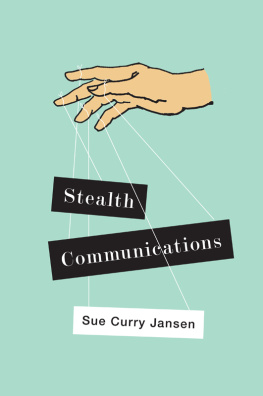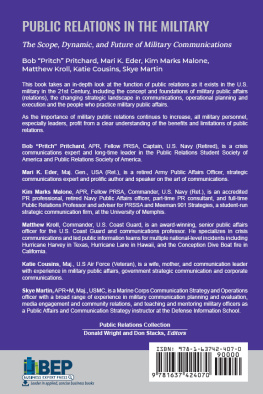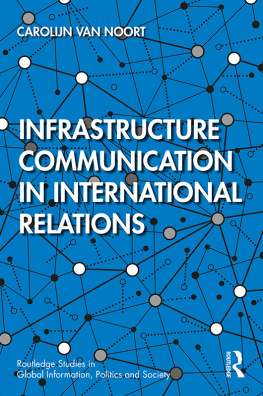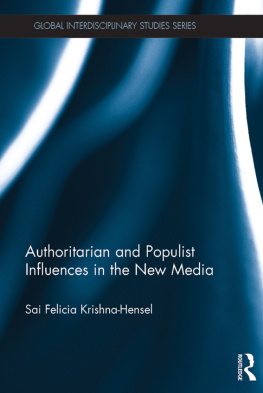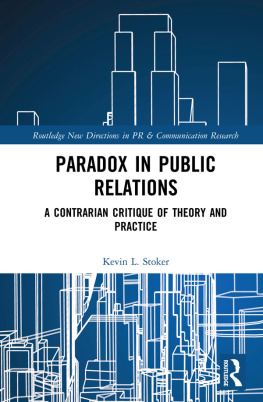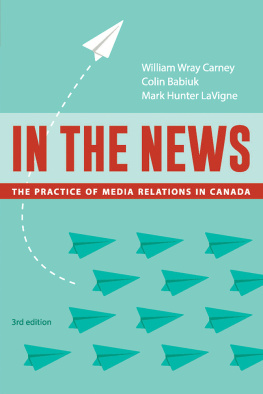
Copyright page
Copyright Sue Curry Jansen 2017
The right of Sue Curry Jansen to be identified as Author of this Work has been asserted in accordance with the UK Copyright, Designs and Patents Act 1988.
First published in 2017 by Polity Press
Polity Press
65 Bridge Street
Cambridge CB2 1UR, UK
Polity Press
350 Main Street
Malden, MA 02148, USA
All rights reserved. Except for the quotation of short passages for the purpose of criticism and review, no part of this publication may be reproduced, stored in a retrieval system, or transmitted, in any form or by any means, electronic, mechanical, photocopying, recording or otherwise, without the prior permission of the publisher.
ISBN-13: 978-0-7456-6481-1
ISBN-13: 978-0-7456-6482-8(pb)
A catalogue record for this book is available from the British Library.
Library of Congress Cataloging-in-Publication Data
Names: Jansen, Sue Curry, author.
Title: Stealth communications : the spectacular rise of public relations / Sue Curry Jansen.
Description: Cambridge, UK; Malden, MA : Polity Press, 2016. | Includes bibliographical references and index.
Identifiers: LCCN 2016020989 (print) | LCCN 2016033115 (ebook) | ISBN 9780745664811 (hardcover : alk. paper) | ISBN 0745664814 (hardcover : alk. paper) | ISBN 9780745664828 (pbk. : alk. paper) | ISBN 0745664822 (pbk. : alk. paper) | ISBN 9781509516025 (mobi) | ISBN 9781509516032 (epub)
Subjects: LCSH: Public relationsHistory.
Classification: LCC HD59 .J366 2016 (print) | LCC HD59 (ebook) | DDC 659.2dc23
LC record available at https://lccn.loc.gov/2016020989
Typeset in 10.5 on 12 pt Sabon
by Toppan Best-set Premedia Limited
Printed and bound in the UK by CPI Group (UK) Ltd, Croydon
The publisher has used its best endeavours to ensure that the URLs for external websites referred to in this book are correct and active at the time of going to press. However, the publisher has no responsibility for the websites and can make no guarantee that a site will remain live or that the content is or will remain appropriate.
Every effort has been made to trace all copyright holders, but if any have been inadvertently overlooked the publisher will be pleased to include any necessary credits in any subsequent reprint or edition.
For further information on Polity, visit our website: politybooks.com
Acknowledgments
All books have more sources than their authors can know or acknowledge. Even some known sources may prefer anonymity, including some of the former and current public relations people who have shared industry stories with me, whether out of amazement, amusement, enthusiasm, indiscretion, indignation, or despair.
The field is vast. Its practitioners range from former world leaders who serve as high-paid strategic consultants, to governments, to unpaid volunteers creating press releases on behalf of their local food banks. Its borders are fluid, as are the tasks it encompasses. Many PR people work for causes that they sincerely believe in, and navigate the ethical challenges they face with integrity. They are not the primary subjects of this book.
Rather, I focus on those PR people who, in George Orwell's famous phase, make a living defending the indefensible, whether on behalf of politics Orwell's primary target markets, or the convergence of the two in neoliberalism. Although not always successful in achieving that goal, these efforts contribute to the disempowerment of ordinary citizens, distrust of public institutions, disenchantment with democracy, and passive acceptance of economic injustices. They also cast a shadow over all PR practitioners and, more importantly, over publicity itself, which, in its original meaning, has an essential role to play in deliberative democracy.
During the conception and development of the book, I have received support and encouragement from my colleagues in the Media and Communication Department at Muhlenberg College, especially Jefferson Pooley, who has pioneered our collective effort to teach public relations from a critical liberal arts perspective. Jeff has read and critiqued the early chapters. Ashley Farkas Patwell and Lora Taub-Pervizpour brought important sources to my attention. I am also indebted to colleagues who participated in our summer writing group, where I tried out some of the ideas explored in this book; they include Jeff (again), Irene Chien, Amy Corbin, John Sullivan, and David Tafler. My collaborations with Brian Martin of the University of Wollongong inform the discussion of backfire in . As always, Marsha Siefert of Central European University has been a thoughtful listener and wise advisor on many related topics. I also want to thank Andrea Drugan and Elen Griffiths at Polity for their helpful suggestions, as well as copyeditor Sarah Dancy for her superb work.
In addition, I have benefited enormously from the foundational work of critical PR authors, both insider scholars and activists and outsider cultural critics and scholars, whose efforts I try to partially synthesize in these pages. Although they are acknowledged in text and notes, my debts to them are greater than those obligatory gestures can capture. Of course, all errors and provocations are my responsibility alone.
This book is dedicated to Ann Curry Bialy and the late Beatrice Curry McKay.
Notes
1946). Bernays (1947).
Introduction: Playing Fast and Loose with Words and Worlds
In his book, The Confidence Men (
In his public statements about the crisis, the new president had been talking tough about Wall Street irresponsibility. The immediate issue precipitating the meeting was the announcement by AIG, the international insurance giant and a beneficiary of the taxpayer funded bailout, that it would pay $160 million in 2008 bonuses a move that fueled public outrage. The meeting began with the CEOs arguing that lucrative bonuses are needed to retain talented people in an international market.
The president interrupted, Be careful how you make those statements, gentlemen. The public isn't buying that.My administration is the only thing between you and the pitchforks. But then, Suskind reports, Obama's flat tone turned to one of support, even sympathy. You guys have an acute public relations problem that's turning into a political problem, he said. And I want to help. But you need to show that you get that this is a crisis and that everyone has to make sacrifices.
The president offered no specific proposals. And according to Suskind, After a moment, the tension seemed to lift: the bankers realized he was talking about voluntary limits on compensation until the storm of public anger passed. It would be for show. The lumps in the throats dissolved and the bankers returned to business as usual.
Assuming Suskind's interpretation is accurate, there are many lessons one could take away from this anecdote about trust, accountability, elite collusion, public opinion, citizen engagement, cynicism, democracy, neoliberalism, too big to fail and more. The simplest is that We have a public relations problem: you, me, the bankers, the president, Americans, and, by extension, much of the world. This book examines our public relations problem: its origins, development, current practices, and implications for the future of democracy.
The public relations industry is an American invention. Only a little over 100 years old, it was exported to the rest of the world in two major waves as America assumed global military and economic dominance after World War II and then reaffirmed and expanded that dominance through globalization after the end of the Cold War.
Next page
